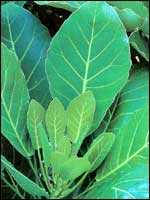Plant Profile: Puka Family: Araliaceae Type: Evergreen Tree Size: 4-6m high The leaves of this grand tropical-looking tree are glossy green and large, being 25-50 cm long and half as wide again. The tree grows into a rounded shape and will branch if encouraged. Heavily veined, the leaves are quite leathery and wavy on the edges. A few weeks before shedding, the leaves turn rich yellow and are quite attractive. The flowers, produced mid-winter, are very small and green. These are followed (on female plants only) by 12mm long black, shiny fruits. Puka is an impressive specimen tree for any garden, especially native or tropical settings. It looks great in patio pots too, but ensure that it does not become too root-bound. There is an extremely attractive variegated form, Meryta sinclairii 'Moonlight', which is cream and yellow with green margins. However, it is not readily available, and although highly sought after, it is expensive and disease prone. Growing Puka is quite hardy in that it can withstand strong winds and salt, making it ideal for coastal areas. However, the tree does not enjoy heavy frosts. Care It is not difficult to propagate by seed in spring when the seed is ripe. Cover with glass and sow in a box at least 18mm deep. Cuttings can be taken, too, but these are difficult to grow. Pukas are susceptible to black spot in humid conditions, and phytophthora (root rot) in wet soil conditions. Both should be treated with a systemic fungicide.
|
Home | Journal
| Newsletter | Conferences
Awards | Join
RNZIH | RNZIH Directory | Links
© 2000–2025 Royal New Zealand Institute of Horticulture
Last updated: June 27, 2007


 Botanical
Name: Meryta sinclairii
Botanical
Name: Meryta sinclairii